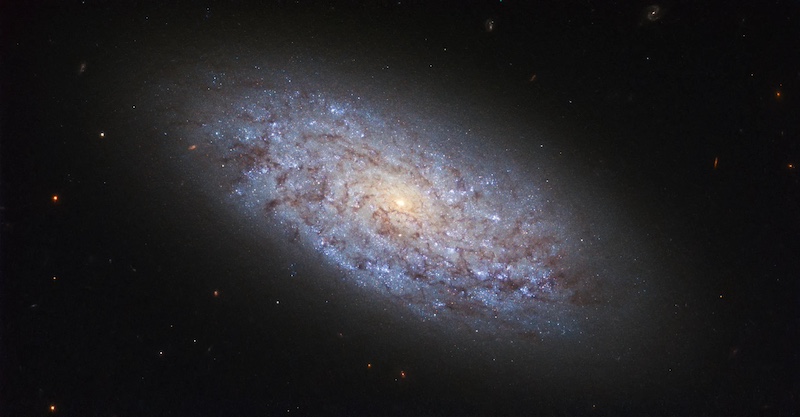Isolated dwarf galaxy not forming stars?
In the past decade, at least, the known population of dwarf galaxies in our universe has been a thorn in the side of astronomers’ comprehension of our cosmos. Now comes another perplexing dwarf galaxy, whose discovery was made possible by NASA’s Webb space telescope. Researchers led by Tim Carleton at Arizona State University said on January 28, 2024, that the dwarf galaxy PEARLSDG is perplexing for two reasons. First, it’s isolated from any massive nearby galaxy. And, second, it’s not undergoing active star formation. That combo – isolated, but apparently filled with old stars – runs contrary to astronomers’ expectations about how dwarf galaxies behave and about how galaxies in general form and evolve.
The researchers published their peer-reviewed findings in The Astrophysical Journal Letters on January 31, 2024.
They presented their research earlier this year at the 237th meeting of the American Astronomical Society (AAS) in New Orleans. You can watch a presentation by Tim Carlton on this subject, on YouTube.
EarthSky lunar calendars are back in stock! And we’re guaranteed to sell out, so get one while you can. Your support means the world to us and allows us to keep going. Purchase here.
Isolated dwarf galaxy that shouldn’t be there
The research team wasn’t looking for an isolated, “old” dwarf galaxy. Their target was a galaxy cluster. But nearby, just off from the primary observation field, they spied the dwarf galaxy, now named PEARLSDG.
Just the fact that it was there at all caught the astronomers’ attention, of course. The galaxy itself, however, is also a bit unusual. At 98 million light-years away, it’s more isolated and quieter than most dwarf galaxies. It is no longer forming new stars and isn’t gravitationally interacting with any other nearby galaxies. As Carleton explained:
These types of isolated quiescent dwarf galaxies haven’t really been seen before except for relatively few cases. They are not really expected to exist given our current understanding of galaxy evolution, so the fact that we see this object helps us improve our theories for galaxy formation. Generally, dwarf galaxies that are out there by themselves are continuing to form new stars.
Dwarf galaxy is quiescent and distant
PEARLSDG is kind of an odd duck. Scientists say that as a dwarf galaxy, it should continue to form new stars. It should also interact with a more massive companion or another nearby galaxy. But PEARLSDG isn’t following the rules. The paper explained:
A wealth of observations has long suggested that the vast majority of isolated classical dwarf galaxies are currently star forming. However, recent observations of the large abundance of “ultra-diffuse galaxies” beyond the reach of previous large spectroscopic surveys suggest that our understanding of the dwarf galaxy population may be incomplete. Here we report the serendipitous discovery of an isolated quiescent dwarf galaxy in the nearby universe, which was imaged as part of the JWST PEARLS Guaranteed Time Observation program.
The stars in the dwarf galaxy are also quite bright, as seen in Webb images. That brightness made it easier for astronomers to calculate the distance to the galaxy, an incredible 98 million light-years.
The researchers used Webb’s Near-InfraRed Camera (NIRCam) to image PEARLSDG. It was NIRCam’s high angular resolution and sensitivity that made it possible to see individual stars in the galaxy.
But Webb wasn’t the only telescope that the astronomers utilized to study PEARLSDG. They also used spectroscopic data from the DeVeny Optical Spectrograph on the Lowell Discovery Telescope in Flagstaff, Arizona, archival imaging from NASA’s Galaxy Evolution Explorer (Galex) and Spitzer space telescope and ground-based imaging from the Sloan Digital Sky Survey (SDSS) and the Dark Energy Camera Legacy Survey (DECaLS).

Colors and wavelengths
The stars in PEARLSDG are some of the most distant ever seen. The astronomers also studied the colors of those stars. They used a wide range of imaging data, including ultraviolet, optical and infrared wavelengths. The data revealed that the stars do not have the color of newly formed stars. This showed that the galaxy is not still producing new stars.
By examining the wavelengths of the light from the stars, using the DeVeney Optical Spectrograph, the astronomers could also observe the motion of the galaxy. The technique involves the well-known Doppler effect. This revealed that PEARLSDG is indeed solitary and not interacting gravitationally with any other nearby galaxies.
The same wavelengths also re-confirmed the other data regarding the ages of the stars. There are very few, if any, young stars in the galaxy.
Overall, PEARLSDG has been a surprise for astronomers, as Carleton noted:
This was absolutely against people’s expectations for a dwarf galaxy like this.
Many more similar isolated dwarf galaxies?
If Webb found this one odd dwarf galaxy by accident, then there are probably more like it out there. As the paper noted:
More detailed analysis of the star formation history of PEARLSDG and the dynamics of PEARLSDG with respect to its surroundings are needed to further understand its formation history, but this discovery suggests the possibility that many isolated quiescent galaxies are waiting to be identified and that JWST has the tools to do so.
Bottom line: Astronomers using NASA’s James Webb Space Telescope accidentally discovered an odd dwarf galaxy that is isolated and much less active than most dwarf galaxies.
Source: PEARLS: A Potentially Isolated Quiescent Dwarf Galaxy with a Tip of the Red Giant Branch Distance of 30 Mpc
Via Arizona State University
Read more: Dwarf galaxy caught ramming into a large spiral
Read more: When our Milky Way merged with an ancient dwarf galaxy